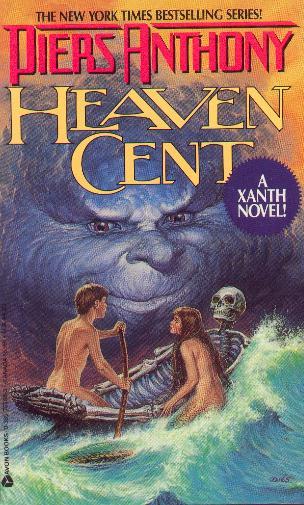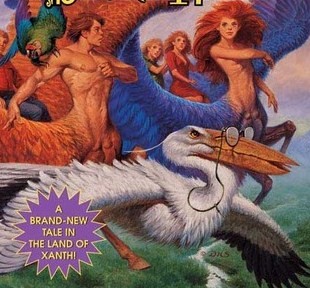Anthony draws you in with his cleverly convoluted plots and endlessly creative puns. Even the titles are punny: Centaur Aisle, Roc and a Hard Place, Currant Events, Stork Naked.
And the covers often involve beautifully realized beefcake (drawn by Darrell K. Sweet): utterly naked young men, beefy knights, muscular centaurs and demons. You expect lots of homoerotic buddy-bonding inside.
But you'll be wrong. All significant relationships are heterosexual. Same-sex friends always betray you in the end. And there are no gay people, anywhere.
Stork Naked proposes that in Xanth, the old tale of babies coming from storks is true; prospective parents simply send the proper forms to the stork headquarters, and wait nine months for delivery. Since no straight intercourse is required, one would expect same-sex partners to apply for babies quite often; but only male-female couples are mentioned.
Every reference to desire, love, or romantic relationships in the book, and in all Xanth books, carefully specifies that it is straight.
When a fairy tells the adventurers about a strange lake filled with “love water,” they ask: “Standard love elixir? Male loves nearest female, and vice versa?”
“Yes. I have seen creatures there. I couldn’t make out exactly what they were doing, but always male and female.”
Piers Anthony could easily let his “standard love elixirs” target the nearest person, and have the fairy say “they were usually male and female.” But he is doggedly deter-mined to keep Xanth gay-free.
In his newsletter, Piers Anthony offered three responses to a fan’s criticism of the ongoing erasure.
First, as someone who is “110% straight,” whatever that means, he could never create believable gay characters (yet he is easily able to create ogres, demons, centaurs, mermaids, and talking storks).
Second, he is afraid that his publisher will not permit such a “controversial” move (but Avon Books has published many books with gay characters).
Third, he is afraid that including a gay character will ruin sales.
Straight science fiction and fantasy fans do seem to be more homophobic than usual. On an online forum, a fan asked why so many gay men like the genre, and was told that it gives them hope: “since sf has new inventions and discoveries, there would be a great possibility for a cure for it.”
A guide to Science Fiction Conventions advised straights who are subject to a same-sex advance to “refuse politely and clearly” instead of physically attacking their “assailant.”
Since the “new wave” of sociological speculation in the 1970s, many science fiction stories have depicted some form of “alternative sexuality.” There are species with three or more sexes or none at all, species whose sex organs change every season or at random, societies where technology makes changing one’s sex as easy as changing one’s shoes. Nevertheless, every sexual encounter, every romance involves a being who is male (right now) and one who is female (right now). The message is clear: one can be attracted only to beings with complementary sex organs; same-sex desire does not exist.
Some stories are set in future or magical societies in which bisexuality is “accepted,” but not people drawn exclusively to the same sex, not gay people, especially not gay men, and any characters who happen to mention in passing that they are bisexual experience only straight passion during the course of this particular story.
The vast majority of science fiction and fantasy stories do't bother with "alternative” sexualities at all, or even with offhand references to bisexuality being “accepted”: there are straight men and women, period.
So why do I keep reading it?
Because occasionally I will find an Earthfasts, a Something Wicked This Way Comes, or a Lord of the Rings.
See also: Michael Moorcock.





Amusing. Piers didn't discuss the gay romance aspect with me. If he had, he'd have as many book sales as I do with my gay-themed scifi novels.
ReplyDeletewww.mark-kendrick.com
To be fair, would you want gay representation to be in the form of Lake Roofie over there?
ReplyDeleteHomo-exclusion should be Anthony's worst problem. The misogyny in his works (starting from his first novel, Chthon) has been commented upon for decades. In Xanth, main (male) characters frequently make snarky comments about women in general; and you have Chameleon, who cycles between a mentally deficient but physically irresistible slut and a hideous but brilliant hag – with the cycles of the moon, just to nail the female caricature completely.
ReplyDelete